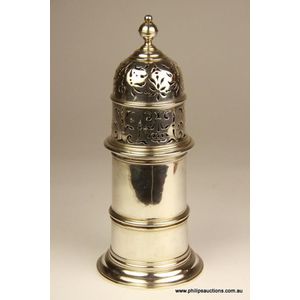Polish 800 Silver Mustard Pot with Spoon
You must be a subscriber, and be logged in to view price and dealer details.
Subscribe Now to view actual auction price for this item
When you subscribe, you have the option of setting the currency in which to display prices to $Au, $US, $NZ or Stg.
- Marrow Spoon - A spoon with a long handle and a narrow scoop shaped bowl, used to scoop and eat marrow from the hollow centre of roasted bones. Some marrow scoops are double ended with a different shaped bowl at each end.
- Hallmarks - A mark stamped on articles of precious metals in Britain, since the 14th century, certifying their purity. It derives its name from the Guild Hall of the Goldsmiths' Company, who recieved its Charter in 1327 giving it the power to assay (test the purity) and mark articles of gold and silver.
The hallmark will consist of several marks, including the:
- silver standard mark, indicating the purity of the metal. Sterling silver is .925 pure silver.
- the city mark indicating the city in which it was assayed eg London, Birmingham, York etc.
- the date mark, usually a letter of the alphabet in a particular font and case,
- a duty mark, indicating whether duty had been paid to the crown, and only in use from 1784 to 1890
The piece may include an additional mark, the maker's mark, although not forming part of the hallmark, will be located in the vicinity of the hallmarks.
Sometimes silver plated items will bear faux hallmarks, often confusing those not familiar with silver markings. - Finial - An architectural decoration, found on the upper parts of of an object. On furniture they are usually found on pediments, canopies and shelf supports. On smaller ceramic or silver items, such as spoons, they may decorate the top of the item itself, or the lid or cover where they provide a useful handle for removal.
Finials have a variety of shapes and forms. They may be urn-shaped, baluster shaped round or spiral, but usually taper into an upper point. Many real life shapes may also be used as finials, such as pineapples, berries, pinecones, buds, lotus and acorns. Sometimes animals such as a lion are depicted, or fish and dolphins.
This item has been included into following indexes:
Visually similar items

A very rare Victorian silver novelty sewing etui, in the form of a lantern. Fitted interior with bobbin holder and needle case by Henry William Dee, London, 1831. 6 cm high.

A Queen Anne Britannia silver caster, London 1702, with unidentified maker's mark of B? over a flower in trefoil, the elegant sectioned pillar with ribbed bands and a small stepped spreading foot, a domed top pierced with scrolled foliate designs surmounte

A George II silver baluster pepperette, the tall domed top with alternating pierced panels, acorn finial, spreading circular foot. London 1737, maker's mark obscured. Weight 93gms. Height 13 cm.

English hallmarked sterling silver sugar Elizabeth II sugar castor having a plain round bellied body with an applied reeded central girdle, a hand-pierced lid with bayonet fit & cast urn-shaped finial, & sitting on a pedestal foot, London, 1976, maker Lgs,
